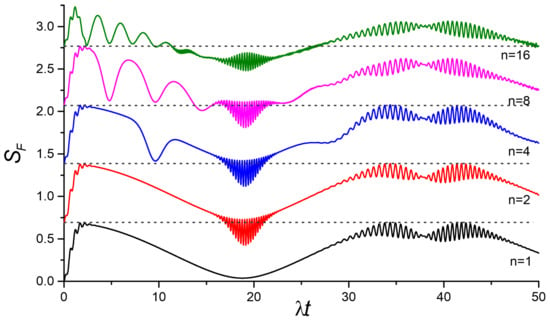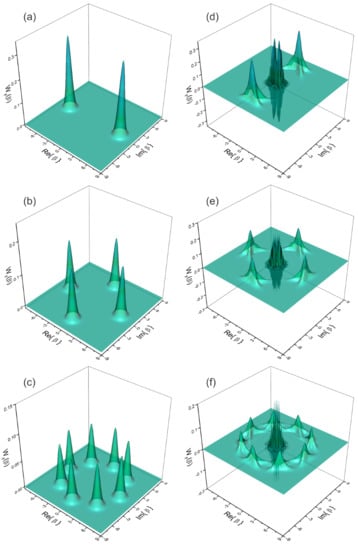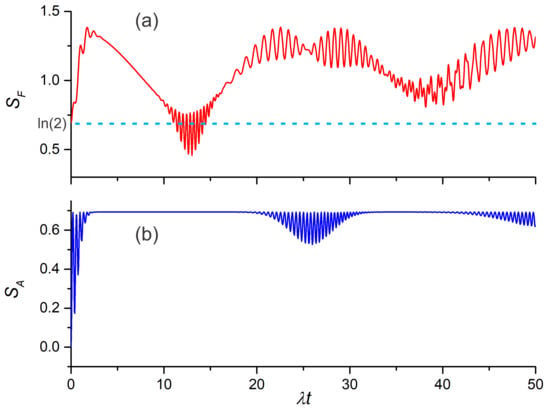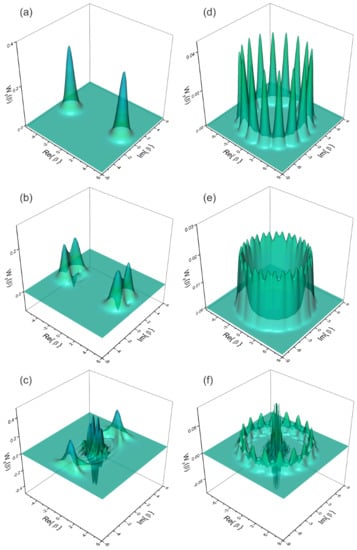Abstract
We investigate some of the fundamental features of the interaction of a mixture of coherent states, namely, a Kaleidoscope states mixture, with two-level atoms in the Jaynes–Cummings model framework. We begin our analysis by calculating the von Neumann entropy of the field, which is determined with the help of the virtual atom method. The oscillations appearing in the entropy indicate a state of purity greater than the initial state, i.e., a purification of the initial state due to a transfer of coherence from the atom to the field. In this oscillatory region, we obtain a negative Wigner function that hints at a (noisy) multiple Schrödinger cat.
1. Introduction
The relation between classical and quantum phenomena has attracted attention over the years, becoming a very discussed problem in quantum mechanics. The main problem is that what causes, in the macroscopic world, the quantum interference of superposition states and the n-qubit entanglement states may not be observed [1,2,3].
Schrödinger cat [4,5,6] states, or superpositions of coherent states, have attracted the attention of researchers due to their fundamental features. Of particular interest is the case of the superposition of two (or more) coherent states [7,8], where, because of quantum interference, their properties are very different from the properties of the constituent coherent states, as well as from the incoherent superposition or statistical mixtures of such states. For example, the superposition exhibits sub-Poissonian photon statistics, higher-order squeezing, and oscillations in the photon number distribution [8]. These properties clearly differentiate the state of the superposition and statistical mixture of two coherent states [7]. Because superpositions of macroscopically distinguishable states (or Schrödinger cat-like states) may be produced by using coherent states, the problem is important for the quantum theory of measurement [9]. Several schemes have already been proposed to produce a superposition of coherent states, for instance the non-linear interaction of the field in a coherent state with a Kerr-like medium can produce their superposition [4]. Another possible way would be through the interaction between quantized fields, initially prepared in coherent states, with two-level atoms [7,8] or ion laser interactions [9].
On the other hand, entropy [9,10,11] is one of the main tools for measuring entanglement [2,12]. Precisely, one of the main tasks in the present manuscript is to calculate the entropy of the field for a mixture of Kaleidoscope states or a statistical mixture of coherent states, in the Jaynes–Cummings framework, which we will do with the aid of the Araki–Lieb inequality [13]. In principle, it seems impossible to use the Araki–Lieb inequality to calculate the field entropy because the field is in a statistical mixture of states [14]. However, via purification of the mixed density matrix of the quantized field [15], we will be able to use that inequality in order to calculate the field von Neumann entropy, either for the atom or the field.
In the next section, we define the Kaleidoscope states that we will consider as the initial state in their interaction with a two-level atom. Section 3 deals precisely with this interaction and, there, we calculate the field entropies and their Wigner functions [16], where we show that the statistical mixture of coherent states, i.e., the Kaleidoscope states mixture, goes to a minimum at half the revival time, independently of its number of components. Finally, in Section 4, we summarize our conclusions.
2. Kaleidoscope States
Kaleidoscope states are a particular superposition of n coherent states, and are defined in reference [17], as:
where are normalization constants and with n, k integers which satisfy .
We can observe that the Vandermonde matrix that transforms the vectors in Equation (1) is proportional to the so-called discrete Fourier transform, also known as the quantum Fourier transform [18].
On the other hand, an initial statistical mixture of n coherent states may be written as
This density matrix may be diagonalized by the virtual atom method [15], where the important issue is to establish a connection between this density and the virtual density operator , which is calculated from the pure state
where is the virtual atom basis and are the Kaleidoscope states, whenever . After tracing the density operator , over the virtual atom states , we obtain the block diagonal density matrix
where
Similarly, by tracing the density over the field basis, we obtain the virtual atom (VA) density matrix
and, taking into account that and , the Equation (6) may be rewritten as:
where
3. Interaction of Kaleidoscope States with a Two-Level Atom
The interaction between a quantized field and a two-level atom (under rotating wave approximation) is given by the Jaynes–Cummings interaction Hamiltonian [19] (for simplicity we have set ),
where we have considered on-resonance conditions (equal field and atomic transition frequencies). In the above equation, is the coupling constant, and and the annihilation and creation operators, respectively, and and are the raising and lowering Pauli operators, respectively. The evolution operator, , in the basis is given by
with and the London phase operators [20]. For details of the above and next results, we refer to the appendices.
If we consider the atom initially prepared in the state and the field in a statistical mixture of n coherent states, i.e., the system is initially prepared in , with defined by (2), then the time evolved density matrix is given by
with
In the study of the interaction between two subsystems, namely atom (A) and field (F), the subsystem entropies and , and the total entropy play an essential role and they obey the Araki–Lieb inequality [13],
Particularly, when the states of the subsystems are prepared in pure states, we have that , and the entropies of the subsystems will be equal . This situation is precisely our case because the states of the field (3) and atom are pure states, and we can apply the virtual atom method [15] in order to find the entropies.
Therefore, tracing over the field states, we obtain the reduced block diagonal virtual atom density matrix
whose eigenvalues are:
for , such that the field entropy can be written in the form
Finally, tracing the density (11) over the atomic states, we obtain the reduced density matrix for the field as
As two coherent states are sufficiently apart when , they may be considered orthogonal. They may be considered orthogonal as and, as becomes larger, the exponential approaches zero. On the other hand, the Kaleidoscope-states are orthogonal for any , and will be a block diagonalizable density as was shown in Equation (16).
The field entropy is plotted as a function of the scaled time in Figure 1, for Kaleidoscope-states with different values of statistical mixture of coherent states, namely, and 16, and . Their initial values are calculated as and are indicated in the figure by dotted lines. It may be seen that the entropies have similar behavior: each one possesses a global minimum of about ; for all values of the field entropy is below the dotted line corresponding to their initial values, making it clear that a purification process takes place. This may be explained as follows: the photon distribution for a mixture of coherent states is a Poissonian distribution, just as the one for a coherent state. This means that the collapses and revivals occur exactly at the same time for each of the components, namely , with the so-called revival time. This phenomenon happens because each of the components of the mixture does not interfere with any other components as the state considered is not a superposition of states but rather a statistical mixture. Once the interaction begins, each component is divided into two counter-rotating components (in phase space, see Figure 2) that produce the purest state precisely at half the revival time [21]. In this region and in each case, the field becomes purer than its initial state and oscillations appear for . Such purification occurs because of a transfer of coherence from the atom to the field [22].

Figure 1.
The evolution of the field entropy of Kaleidoscope-States as a function of the scaled time and different values of statistical mixture of coherent states and 16, with . Their initial values are calculated as and are indicated in the figure by dotted lines.

Figure 2.
Wigner function for Kaleidoscope-State with for several values of the time and n. For : (a) , (b) and (c) ; for : (d) , (e) and (f) .
Here, some questions arise: what will the form of the above-mentioned purer states for different values of a statistical mixture of coherent states n about be? What will the form of the state where the field entropy reaches its maximum value for different values of a statistical mixture of coherent states n be? In order to try to answer the above questions, we calculated the field Wigner function for the reduced density matrix field defined in Equation (19). The Wigner function may be written as [16]
where is the displacement operator.
In Figure 2a–c, we show the field Wigner function at , and we clearly see the two, four, and eight peaks corresponding to each coherent state for and 8, respectively. Additionally, in Figure 2d–f, we show the field Wigner function corresponding to the Kaleidoscope-State with and 8 respectively when the field would become a purer state at time . These Wigner functions resemble a Schrödinger cat state of and 8 components, where we note the characteristic interference structure. We clearly see the formation of quantum interferences halfway between the n humps. As we mentioned above, once the interaction starts, each of the components is divided into two counter-rotating terms and, at half the revival time, the humps recombine with the traveling contributions from other component states; that, however, is not a coherent process, as each one of the components interferes only with itself. At that time, the Wigner function becomes negative, which is a clear signature of a non-classical state. This fact, plus the purification of the field shown in Figure 1, hints that multiple Schrödinger cats are being generated. The frequency of the interference structure increases as the separation distance increases [23]. For example, setting and , the entropy has a similar behavior as in Figure 1 but, as we can see in Figure 3a, now its minimum is around , and its corresponding field Wigner function has an interference structure with a lower frequency, as is shown in Figure 4c. Finally, when , the initial mixture of Kaleidoscope States (as we showed in Figure 2a–c) gains purity as was suggested by the entropy behavior, and the negativity of the field Wigner function are an indicator of the non-classical properties of the state [23] at .

Figure 3.
The evolution of the: (a) field entropy and (b) and atom entropy; for a Kaleidoscope-State as a function of the scaled time with and . The initial value of field entropy is calculated as and is indicated in the figure by a dotted line.

Figure 4.
Field Wigner function for Kaleidoscope-State for several values of the time and n. For (a) , (b) and (c) . And for (d) , (e) and (f) .
On the other hand, for the case of the maximum value of the field entropy as it is shown in Figure 3a, we see that each peak of the initial coherent state in Figure 4a, split into two counter-rotating terms, where each one of the components interferes only with itself and spread on the circle of radius , and the Wigner function, may have negative values, as is shown in Figure 4b, which is an indicator of the non-classical properties of the state [23].
For the sake of completeness, the atom entropy is plotted in Figure 3b as a function of the scaled time with and . This entropy quickly saturates to the value of , and it may be seen that the entropy has similar behavior for other values of n and .
The above results can be compared with previous ones in Figure 1 for and . In that case, it was shown that the field entropy has its minimum around . In Figure 4d, we show the field Wigner function at , and we clearly see the sixteen peaks corresponding to each of coherent states. For the case of the maximum value of the field entropy (), we see that each peak of the initial coherent state splits into two counter-rotating terms, where each component interferes only with itself, and it the formation of the quantum interference structure on the circle of radius may also be seen. In this case, the Wigner function has no negative values. Finally, when the time goes to , the peaks interfere and the formation of the quantum interference structures may be seen halfway between the 16 humps, which is a clear signature of a non-classical state.
4. Conclusions
We have shown that the Jaynes–Cummings interaction with an initial Kaleidoscope mixture of coherent states may be modeled by the virtual Hamiltonian method by extending the atomic Hilbert space such that a virtual pure state may be associated as an initial wavefunction. In particular, we have seen that the purification procedure takes us from a mixed field density matrix to a pure wave function that involves a virtual -level atom, as can be seen in the terms in Equation (19). Finally, we should mention that the effects presented in the field entropy for the initial field state given by a statistical mixture of the constituent states are reflected in the appearance of oscillations that give rise to negative Wigner functions resembling multiple Schrödinger’s cats.
Author Contributions
Conceptualization, J.A.A.-C.; investigation, all authors; methodology, all authors; software, all authors; validation, all authors; formal analysis, all authors; writing—original draft preparation, all authors; writing—review and editing, all authors. All authors have read and agreed to the published version of the manuscript.
Funding
This research received no external funding.
Institutional Review Board Statement
Not applicable.
Informed Consent Statement
Not applicable.
Data Availability Statement
The data presented in this study are available upon request from the corresponding author.
Conflicts of Interest
The authors declare no conflict of interest.
Appendix A. Initial Field Density
Following the virtual atom method to the density matrix (2) we propose:
where for simplicity we represented the ket in the Hilbert space by the standard basis of n dimensional Euclidean space as:
(we do here as it is done when dealing with Pauli-spin operators: one may go to the matrix form or work with the well known operators). From Equation (1) and considering orthogonal properties of Discrete Fourier Transform (DFT), one has
Thus, according to the above formula (A3), we can rewrite Equation (A1) as:
where
with
then these new virtual atom states are orthogonal kets because the discrete Fourier transform (DFT) is an orthogonal matrix too.
Using the above results it can be shown that the density matrix associated with defined by Equation (A1) will be
where we have used relation (A4). Taking the trace of the density matrix (A7) over the field states we get the virtual atom density operator
But in reference [17], it was remarked that Kaleidoscope states are orthogonal, then
We will now do an analysis of the eigenvalue problem for , which we may start writing
where
with . When , we have
as , then we have eigenvalue
In a similar fashion, for we have
Because , we can cancel the last two sums in Equation (A14), and we have that
as , then we have eigenvalue
With the help of Equations (A12) and (A15), the eigenvalue Equation (A10) can be written as,
Now, taking the trace of the density matrix (A7) over field states we get the field density:
Appendix B. Jaynes-Cummings Dynamics
The Jaynes-Cummings time evolution operator is given by
where and are the London phase operators [20]. If we consider the initial density matrix , where was defined in Equation (4), we obtain:
where,
Nevertheless, Kaleidoscope states can be rewritten as:
With the above relation, we can write
From the time evolution density matrix (A20), we can obtain the reduced block diagonal atom density matrix by tracing over the field states, so that
whose characteristic polynomial is:
and we get the eigenvalues
for . By recalling the properties of the trace of the block diagonal matrix we calculate the atomic von Neumann entropy defined as
Finally, by tracing the density (A20) over the atomic states, we obtain the reduced density matrix for the field as
References
- Man, Z.X.; Zhang, Y.J.; Su, F.; Xia, Y.J. Entanglement dynamics of multiqubit system in Markovian and non-Markovian reservoirs. Eur. Phys. J. D 2010, 58, 147–151. [Google Scholar] [CrossRef]
- Nourmandipour, A.; Tavassoly, M.K.; Rafiee, M. Dynamics and protection of entanglement in n-qubit systems within Markovian and non-Markovian environments. Phys. Rev. A 2016, 93, 022327. [Google Scholar] [CrossRef]
- Doll, R.; Wubs, M.; Hänggi, P.; Kohler, S. Incomplete pure dephasing of N-qubit entangled W states. Phys. Rev. B 2007, 76, 045317. [Google Scholar] [CrossRef]
- Yurke, B.; Stoler, D. Generating quantum mechanical superpositions of macroscopically distinguishable states via amplitude dispersion. Phys. Rev. Lett. 1986, 57, 13–16. [Google Scholar] [CrossRef] [PubMed]
- Brune, M.; Haroche, S.; Raimond, J.M.; Davidovich, L.; Zagury, N. Manipulation of photons in a cavity by dispersive atom-field coupling: Quantum-nondemolition measurements and generation of “Schrödinger cat” states. Phys. Rev. A 1992, 45, 5193–5214. [Google Scholar] [CrossRef] [PubMed]
- Davidovich, L. From quantum to classical: Schrödinger cats, entanglement, and decoherence. Phys. Scr. 2016, 91, 063013. [Google Scholar] [CrossRef]
- Moya-Cessa, H.; Vidiella-Barranco, A. On the Interaction of Two-level Atoms with Superpositions of Coherent States of Light. J. Mod. Opt. 1995, 42, 1547–1552. [Google Scholar] [CrossRef]
- Vidiella-Barranco, A.; Moya-Cessa, H.; Bužek, V. Interaction of Superpositions of Coherent States of Light with Two-level Atoms. J. Mod. Opt. 1992, 39, 1441–1459. [Google Scholar] [CrossRef]
- Barnett, S.; Phoenix, S. Entropy as a measure of quantum optical correlation. Phys. Rev. A 1989, 40, 2404–2409. [Google Scholar] [CrossRef]
- Phoenix, S. Wave-packet evolution in the damped oscillator. Phys. Rev. A 1995, 41, 5132–5138. [Google Scholar] [CrossRef]
- Barnett, S.M.; Beige, A.; Ekert, A.; Garraway, B.M.; Keitel, C.H.; Kendon, V.; Lein, M.; Milburn, G.J.; Moya-Cessa, H.M.; Murao, M.; et al. Journeys from quantum optics to quantum technology. Prog. Quantum Electron. 2017, 54, 19–45. [Google Scholar] [CrossRef]
- Golkar, G.; Tavassoly, M. Atomic motion and dipole–dipole effects on the stability of atom–atom entanglement in Markovian/non-Markovian reservoir. Mod. Phys. Lett. A 2019, 34, 1950077. [Google Scholar] [CrossRef]
- Araki, H.; Lieb, E.H. Entropy inequalities. Commun. Math. Phys. 1970, 18, 160–170. [Google Scholar] [CrossRef]
- Zúñiga-Segundo, A.; Juárez-Amaro, R.; Aguilar-Loreto, O.; Moya-Cessa, H.M. Field’s entropy in the atom–field interaction: Statistical mixture of coherent states. Ann. Phys. 2017, 379, 150–158. [Google Scholar] [CrossRef]
- Anaya-Contreras, J.A.; Zúñiga-Segundo, A.; Moya-Cessa, H.M. Purification of the atom-field interaction Hamiltonian. Phys. Open 2019, 1, 100007. [Google Scholar] [CrossRef]
- Moya-Cessa, H.; Knight, P.L. Series representation of quantum-field quasiprobabilities. Phys. Rev. A 1993, 48, 2479–2481. [Google Scholar] [CrossRef]
- Koçak, A.; Pashaev, O.K. Special functions with mod N Symmetry Kaleidosc. Quantum Coherent States. J. Phys. Conf. Ser. 2019, 1194, 012059. [Google Scholar] [CrossRef]
- Perez-Leija, A.; Andrade-Morales, L.A.; Soto-Eguibar, F.; Szameit, A.; Moya-Cessa, H.M. The Pegg–Barnett phase operator and the discrete Fourier transform. Phys. Scr. 2016, 91, 043008. [Google Scholar] [CrossRef]
- Jaynes, E.; Cummings, F. Comparison of quantum and semiclassical radiation theories with application to the beam maser. Proc. IEEE 1963, 51, 89–109. [Google Scholar] [CrossRef]
- Susskind, L.; Glogower, J. Quantum mechanical phase and time operator. Phys. Phys. Fiz. 1964, 1, 49–61. [Google Scholar] [CrossRef]
- Gea-Banacloche, J. Atom- and field-state evolution in the Jaynes-Cummings model for large initial fields. Phys. Rev. A 1991, 44, 5913–5931. [Google Scholar] [CrossRef]
- Arancibia-Bulnes, C.A.; Moya-Cessa, H.; Sánchez-Mondragón, J.J. Purifying a thermal field in a lossless micromaser. Phys. Rev. A 1995, 51, 5032–5034. [Google Scholar] [CrossRef]
- Kenfack, A.; yczkowski, K. Negativity of the Wigner function as an indicator of non-classicality. J. Opt. B Quantum Semiclassical Opt. 2004, 6, 396–404. [Google Scholar] [CrossRef]
Disclaimer/Publisher’s Note: The statements, opinions and data contained in all publications are solely those of the individual author(s) and contributor(s) and not of MDPI and/or the editor(s). MDPI and/or the editor(s) disclaim responsibility for any injury to people or property resulting from any ideas, methods, instructions or products referred to in the content. |
© 2023 by the authors. Licensee MDPI, Basel, Switzerland. This article is an open access article distributed under the terms and conditions of the Creative Commons Attribution (CC BY) license (https://creativecommons.org/licenses/by/4.0/).